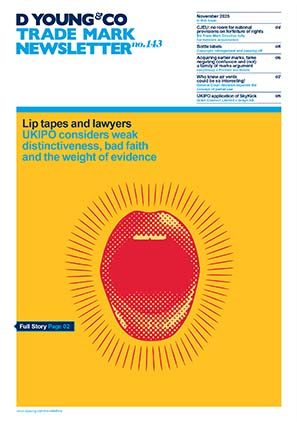Pedantry on ice: High Court explores the relationship between trade marks and their descriptions
British supermarket chain Iceland applied for a summary judgment regarding a dispute over Babek International’s registered trade mark (shown below). Initially, Babek claimed the mark had been infringed by Iceland selling a product bearing the sign; as a result, Iceland counterclaimed for invalidity of the mark.
At the core of this case is the relationship between the visual and written representations of the trade mark. The trade mark registration was accompanied by a description that read “Gold oval with embossed BABEK writing. Colour claimed: Gold, Black”.

Clarity and precision
Iceland asserted that the trade mark failed to comply with s1(1) of the Trade Marks Act 1994. It is well established that to satisfy s1(1), a trade mark must satisfy the Sieckmann criteria: it must be clear, precise, self-contained, easily accessible, intelligible, durable and objective. Iceland claimed the mark lacked the requisite clarity and precision to meet the criteria.
To support its position, Iceland put forward six distinct arguments. Broadly, these arguments asserted that the description of the mark was inconsistent with its visual representation. Consequently, the mark lacked clarity and precision, undermining Sieckmann and by extension s1(1) of the Trade Marks Act 1994.
Iceland’s arguments can be summarised as follows:
- The mark was described, in the original European Union trade mark (EUTM), which was later cloned following Brexit, as figurative yet could be interpreted as three-dimensional due to references to embossed elements.
- The description failed to specify the style, placement, or precise hues of the writing and colours.
- There were several inconsistencies between the verbal description and the visual representation, including: only “BABEK” was described as embossed, while other elements appeared embossed visually; the description referred to an oval, but the graphic displayed an ellipse; and the colour black was claimed in the description, yet was absent visually, with only shadows present.
- The visual representation displayed various hues of gold, none of which were identified in the description.
- The description did not specify the particular shade of black claimed and black was not even visually present.
- Colours beyond gold and black appeared in the visual representation, despite only those two being claimed.
These arguments were rejected in their entirety as the judge concluded that finding the two representations of the mark to be inconsistent would demand an “assumed degree of pedantry” and “make the trade mark system unworkable”.
The pedantic nature of these arguments is exemplified by the judge’s analysis that the shadows in the mark could not reasonably be described as gold or any other colour, leading to the inclusion of black in the verbal description, despite no black appearing visually.
Similarly, the judge quickly dismissed the subtle distinction between an oval and ellipse as “high grade pedantry” given both are variations of elongated circular shapes.
Colour hues
The most interesting point of contention surrounded the lack of specified colour hues. On this issue, the judge drew from Sainsbury’s v Babybel, in which it was considered that colour hues of the famous Coca-Cola and Tesco marks could “vary without affecting the mark’s capacity to distinguish”. Consequently, in the judge’s view, specific colour hues or Pantone numbers are unnecessary to satisfy the Sieckmann criteria, for marks of this type.
Overall, this conclusion on the colour hue issue is emblematic of the judge’s reasoning for rejecting most of Iceland’s arguments. The view that a trade mark description, which does not detail every element of a mark, is not automatically inconsistent with the visual representation. To conclude otherwise would make trade marks completely impractical.
As a result, the mark was found to satisfy the Sieckmann criteria and consequently s1(1).
In short
A key takeaway from this case is that the judge adopted a pragmatic approach to interpreting trade mark descriptions, placing emphasis on the functional purpose of trade marks. Accordingly, when drafting descriptions, the focus should be on clearly identifying the essential features of the mark, rather than overloading the description with overly technical detail. A lack of minute specificity is unlikely to be problematic, supporting a trade mark system that remains both accessible and commercially sensible.
Moreover, this case reinforces the principle that compliance with the Sieckmann criteria does not typically require the inclusion of specific Pantone references, for every type of mark.
Case details at a glance
Jurisdiction: England & Wales
Decision level: High Court
Parties: Babek International Limited v Iceland Foods Limited and Nathan Hepurker
Date: 11 March 2025
Citation: [2025] EWHC 547 (IPEC)
Decision: dycip.com/2025-ewhc-547-ipec

